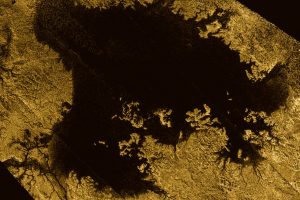このサイトはNASAの土星探査機カッシーニについてのまとめサイトなのですが、今回のNASAの画像はカッシーニの撮影したものではありません。
先日打ち上げられたハッブル宇宙望遠鏡により撮影された最新の土星の画像です。
NASAのオリジナル記事を紹介する前にカッシーニが撮影した土星画像と比較してみましょう。
カッシーニとハッブル宇宙望遠鏡の撮影した土星

撮影日:2018年6月27日、撮影場所:土星から約13億6000マイル、Credits: NASA, ESA, Amy Simon and the OPAL Team, and J. DePasquale (STScI)
ちなみに記事にされている元画像はこちら(サムネイル画像をクリックすると拡大表示(2000×1230)します)

NASAオリジナル記事
Hubble Takes Portrait of Opulent Ring World
Saturn is by far the solar system’s most photogenic planet, and in this latest Hubble Space Telescope snapshot it is especially so because Saturn’s magnificent ring system is near its maximum tilt toward Earth (which was in 2017).
Hubble was used to observe the planet on June 6, 2018, when Saturn was only approximately 1.36 billion miles from Earth, nearly as close to us as it ever gets.
Saturn was photographed as it approached a June 27 opposition, when the planet is directly opposite to the Sun in the night sky and is at its yearly closest distance to the Earth. Though all of the gas giants boast rings, Saturn’s are the largest and most spectacular, stretching out eight times the radius of the planet.
Saturn’s stunning rings were first identified as a continuous disk around the planet by Dutch astronomer Christiaan Huygens in 1655. 325 years later, NASA’s Voyager 1 spacecraft flyby of Saturn resolved thousands of thin, fine ringlets. Data from NASA’s Cassini mission suggests the rings formed 200 million years ago, roughly around the time of the dinosaurs and Earth’s Jurassic period. The gravitational disintegration of one of Saturn’s small moons created myriad icy debris particles, and collisions today likely continually replenish the rings.
Visible in this Hubble image are the classic rings as recorded by early skywatchers. From the outside in are the A ring with the Encke Gap, the Cassini Division, the B ring, and the C ring with the Maxwell Gap.
Saturn’s appearance changes due to its seasons, caused by the planet’s 27-degree axial tilt. It is now summer in Saturn’s northern hemisphere and the atmosphere is more active. This may be responsible for a string of bright clouds visible near the northern polar region that are the remnants of a disintegrating storm. Small, mid-latitude puffs of clouds are also visible. Hubble’s view also resolves a hexagonal pattern around the north pole, a stable and persistent wind feature discovered during the Voyager flyby in 1981.
Saturn’s colors come from hydrocarbon hazes above the ammonia crystals in the upper cloud layers. Unseen lower-level clouds are either ammonium hydrosulfide or water. The planet’s banded structure is caused by the winds and the clouds at different altitudes.
This is the first image of Saturn taken as part of the Outer Planet Atmospheres Legacy (OPAL) project. OPAL is helping scientists understand the atmospheric dynamics and evolution of our solar system’s gas giant planets.
Credits: NASA, ESA, Amy Simon and the OPAL Team, and J. DePasquale (STScI)
Last Updated: July 28, 2018
Editor: Karl Hille
補足説明
上記記事では特に目新しい情報は無く、画像撮影時は土星の北半球は夏とのことです。
(土星の外観は季節ごとに変化しています)
土星の外観を特徴付ける色については、土星大気の最上層部にあるアンモニアの結晶からなる雲の上に漂う炭化水素によるものだとしています。











